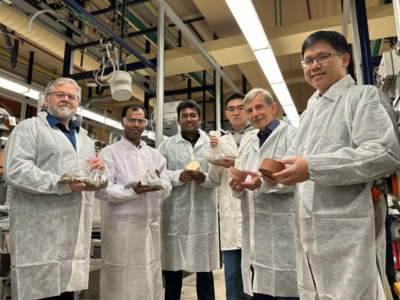This post was originally published on Sustainability Matters

RMIT University engineers have created a new type of energy-efficient brick from scrap materials.
In collaboration with Australian recycling company Visy, the engineers used a minimum of 15% waste glass and 20% combusted solid waste (ash) as substitutes for clay in their bricks.
Team leader Associate Professor Dilan Robert said about 1.4 trillion bricks were used in construction projects globally every year.
“Business-as-usual brick production produces harmful emissions — including carbon dioxide, sulfur dioxide and chlorine — and puts a serious strain on our natural resources, particularly clay,” said Robert, from RMIT’s School of Engineering.
Replacing clay with waste materials in the production of the new bricks helped reduce the firing temperature by up to 20% compared with standard brick mixtures, offering potential cost savings to manufacturers.
Team leader Associate Professor Dilan Robert (third from left) with the RMIT research team behind the energy-smart bricks in a lab at RMIT University. Credit: Seamus Daniel, RMIT University.
Importantly, test results indicated that using these bricks in the construction of a single-storey building could reduce household energy bills by up to 5% compared to regular bricks, due to improved insulation.
In addition to their energy efficiency benefits, the new bricks comply with stringent structural, durability and environmental sustainability standards, with the technology meeting the key compliance requirement of fired clay bricks set by Standards Australia (AS 3700).
“Bricks play a key role in preventing energy loss from buildings,” Robert said.
“We can also produce lightweight bricks in a range of colours from white to dark red by changing our formulations.”
Dr Biplob Pramanik, the RMIT team’s environmental engineer, said the new bricks were safe to use in construction projects.
“Our bricks, manufactured from industry waste, meet state environmental regulations,” he said.

Waste glass that the team can use in their energy-smart bricks. Credit: Seamus Daniel, RMIT University.
In Victoria, Visy recycles glass packaging back into new bottles and jars. The new bricks provide a solution for the use of fines — pieces of glass smaller than 3 mm — which cannot be recycled into bottles.
Paul Andrich, Innovation Project Manager at Visy, said the company was thrilled to find a solution for material that cannot be recycled into food and beverage packaging.
“Diverting this waste into bricks with added insulation, rather than landfill, is another way we are powering the circular economy,” he said.
The researchers now plan to expand the use of their technology.
“We are focusing on scaling up the production process to facilitate the commercialisation of our innovative bricks in collaboration with brick manufacturers in Melbourne,” Robert said.
The team is also looking to collaborate with industry to explore applications of waste material in other construction products.
Their latest research has been published in the international journal Construction and Building Materials.
Top image caption: The team’s energy-smart bricks in a range of colours. Credit: Seamus Daniel, RMIT University.





0 Comments